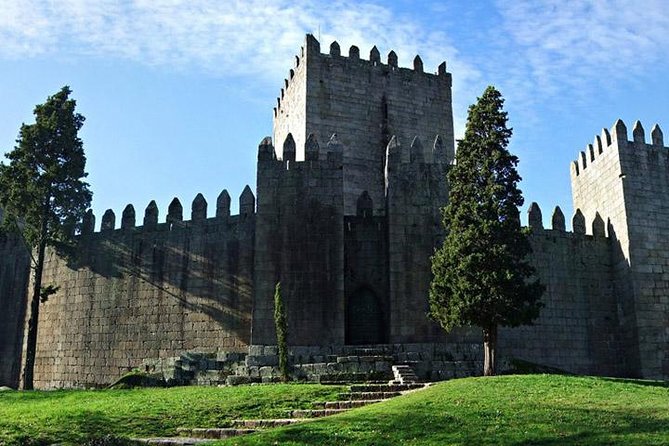
Private tour to Guimarães and Braga
The Minho region, where the cities of Guimarães and Braga are located, owes its recognition, importance and name to the Minho River, one of the four largest rivers in Portugal. Embraced by an extensive and verdant natural area, we are presented by the famous Green Wine that creates a symbiosis as special as the grooves from which the nectar comes. Also, we can’t ignore the fact that it was in this location that the Portuguese County was created.
Options
Car
Private Car tour to Historic Minho (maximum 3 people)
Pickup included
What's included in Private tour to Guimarães and Braga
(Subject to Option Inclusions)Itinerary
Guimaraes Castle
The Castle of Guimarães (Portuguese: Castelo de Guimarães), is the principal medieval castle in the municipality Guimarães, in the northern region of Portugal. It was built under the orders of Mumadona Dias in the 10th century to defend the monastery from attacks by Moors and Norsemen. The castle is a military fortification grounded primarily in the late Romanesque period, and elaborated during the early Gothic epoch of Portuguese architecture. Its area is delineated by walls forming a pentagram, similar to a shield, that includes eight rectangular towers, military square and central keep. Originating in the foundations of a Roman structure, from the writings of Alfredo Guimarães, it was later elaborated on the French model, in its current the form of a shield, with reduced central yard and difficult accesses. It includes several Gothic characteristics, owing to its remodelling at the end of the 13th century, when the keep and residences were constructed (possibly over pre-existing structures).
Paco dos Duques de Braganca
The Palace of the Dukes of Braganza (Portuguese: Paço dos Duques de Bragança) is a medieval estate and former residence of the first Dukes of Braganza, located in the historical centre of Guimarães (Oliveira do Castelo), in the north-western part of Portugal. It was initiated between 1420 and 1422 by Afonso, Count of Barcelos, the illegitimate son of John I of Portugal (and future Duke of Bragança), after his marriage to his second wife. His prodigeny would occupy the space until the Dukes of Braganza moved to Vila Viçosa, abandoning the palace. The 16th Century marked the beginning of period of ruin, which was aggravated during the 19th century, when the local population used the palace as a personal quarry. During the Estado Novo regime, a controversial restoration restored the Palace, while implying a grandeur that may not have existed. The Palace of the Dukes was classified as a National Monument (Portuguese: Monumento Nacional) in 1910, and has been an official residence for the Presidency.
Centro Historico de Guimaraes
Historic Centre of Guimarães is an urban space of the city of Guimarães, in Portugal, tracing back to medieval age covering an area of 16 hectares and retaining many buildings from the medieval age until 19th century. Since 2001, it is declared as a World Heritage Site of UNESCO. Guimarães is closely linked to the formation of national identity and of Portuguese language in 12th century. It is the native city of Afonso Henriques, the first king of Portugal, who in 1139, declared independence of the country.
Inclusions
- Hotel pick up and drop off
- WiFi on board
- Bottled water
- Air-conditioned vehicle
- Driver/Guide
- Lunch
- Monuments entrances
- Specialized infant seats are available
- Infants and small children can ride in a pram or stroller
- Service animals allowed
- Public transportation options are available nearby
- Suitable for all physical fitness levels
- Children must be accompanied by an adult
- The total tour duration includes travel time
Meet
Pickup and Dropoff
Choose to be picked up from a list of locations
Please arrive at the pick up point 10 minutes before departure time.
Additional Information
Centrally located Porto hotels



